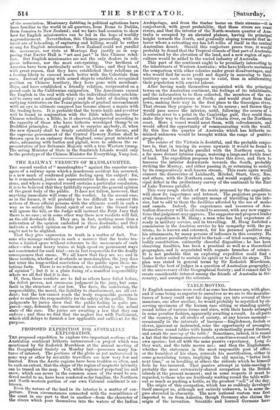PROPOSED EXPEDITION FOR AUSTRALIAN EXPLORATION.
TAB proposed expedition to explore two important sections of the Australian continent hitherto =traversed—a project which was mentioned by Sir Roderick Murchison at the annual meeting of the Geographical Society on Monday last—possesses many fea- tures of interest. The portions of the globe as yet untraversed in some way or other by scientific travellers are now very few and limited. Even the Arctic regions have been trodden so often, and to such an extent, that the shape of the region of magnetic intensity can be traced on the map. Yet, while regions of perpetual ice and snow, which can never m the common sense of the word be ren- dered useful to us, have been rendered so far familiar, the Northern and North-western portion of our own Colonial continent is un- known.
Even the nature of the land in its interior is a matter of con- pc' tune. From circumstances connected with the resemblance of the coast in one part to that in another—from the character of the rivers which pour themselves into the waters of the Indian Archipelago, and from the timber borne on their streams—it is conjectured, with great probability, that those rivers are coast rivers, and that the interior of the North-western quarter of Aus- tralia is occupied by an elevated plateau, having its principal height towards the Borth, and gradually sloping towards that in- terior where a retreating sea has left relics of itself in the central Australian desert. Should this conjecture prove true, it would probably be found that the Tropical climate of that part of Australia is corrected by the elevation of the land, and a new region of agri- culture would be added to the varied industry of Australia. This part of the continent ought to be peculiarly interesting to the inhabitants of Western Australia; who have hitherto sustained the comparison with other colonies under great disadvantages, and who would find far more profit and dignity in annexing to their territory one such as we suppose to exist, than in adulterating their population with convict labour.
After having made themselves acquainted with the principal towns on the Australian continent, the feelings of its inhabitants, and the information to be thus collected, the members of the ex- pedition would rendezvous at Perth ; and would start from that town, making their way in the first place to the Gascoigne river. That stream they propose to trace to its source ; and thence they would pass across the interior, until, following the course of a Northern river to a point in the Cambridge gulf, they could thus make their way to the mouth of the Victoria river, on the Northern coast. Here a vessel would meet them, with refreshments, and would afford the opportunity of communicating with the world. By this line the quarter of Australia which has hitherto re- mained unknown would be brought within the range of positive geography.
The course of the Victoria is doubtful, and the probable conjec- ture is, that in tracing its source upwards it would be found to bend, behind the heights parallel with the Northern coast, to a far more distant interior range, watering a large.and fertile tract of land. The expedition proposes to trace this river, and then to traverse the interior downwards towards the South, probably striking the Murray, and either passing it, or returning to society by its comparatively well-known stream. This route again would connect the discoveries of Leichardt, Mitchel, Start, Grey, Roe, and others, with the Northern coast, and would supply the prin- cipal defect in the preliminary survey of the continent to the East of Lake Torrens parallel.
This very rough sketch of the route proposed by the expedition will show its importance and interest. The projectors propose to avail themselves of the ordinary means of travelling in the inte- rior, but to add to them the facilities afforded by the use of mule. and camels. Indeed, the experiences and resources of Aus- tralian discovery will be all turned to account, with any new sugges- tions that judgment may approve. The suggester and proposed leader of the expedition is M. Hang ; a man who has had experience al- ready in military service, and in travelling. M. Haug forfeited a commission in the Austrian service by his sympathy with the pa- triots; he is known and esteemed, for his personal qualities and his attainments, by many persons of influence in this country. He is of a nature peculiarly suited to the task—of tried courage, strong bodily constitution, eminently cheerful disposition ; he has keen observing faculties, has been a practical as well as a theoretical geographer, and is acquainted with cognate branches of science. It is not probable that an exploring expedition could find a leader better suited to sustain its spirit or to direct its steps. The plan was stated in general terms by Sir Roderick Murchison, (himself the best of judges in a question of Australian geography,) at the anniversary of the Geographical Society; and it cannot fail to create considerable interest among the friends of Australia in this country, and amongst the colonists.


































 Previous page
Previous page